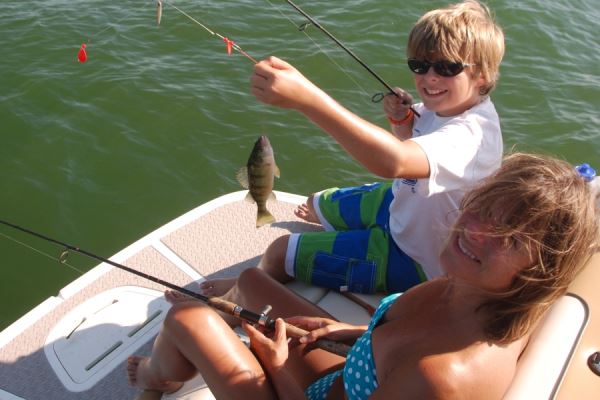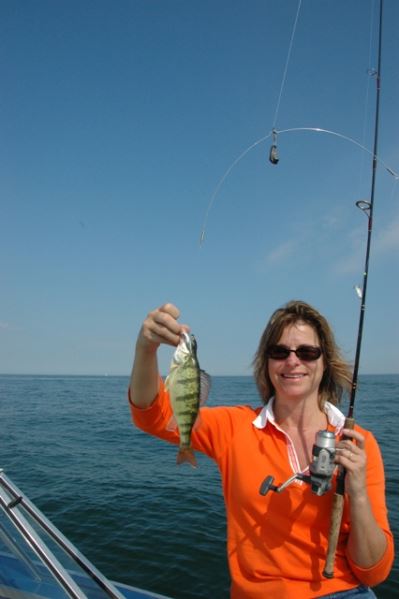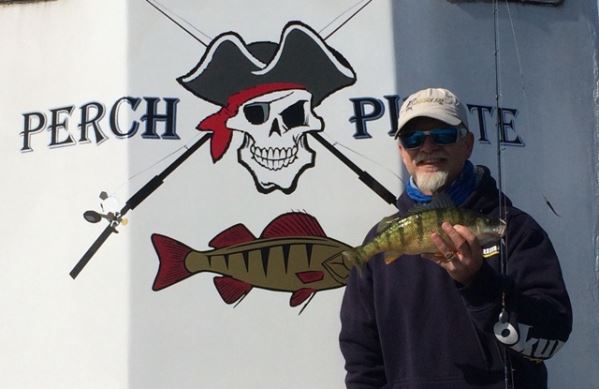 Yellow perch popularity typically peaks about this time each season across several of our Great Lakes where the sweet-tasting panfish are relished. Even when they are not the targeted species, coolers of “yellow gold” have saved many a late-season fishing trip when more popular gamefish proved to be less cooperative. Not so the past couple of seasons, however, in some popular ‘perch-jerking’ waters where if not exactly fewer, the fish have been far between.
Yellow perch popularity typically peaks about this time each season across several of our Great Lakes where the sweet-tasting panfish are relished. Even when they are not the targeted species, coolers of “yellow gold” have saved many a late-season fishing trip when more popular gamefish proved to be less cooperative. Not so the past couple of seasons, however, in some popular ‘perch-jerking’ waters where if not exactly fewer, the fish have been far between.
For example, the perch-rich waters of Lake Erie’s Western Basin play host to some of the Great Lakes’ most avid perch-miners, who have been frustrated of late of the apparent paucity of their go-to species. The same goes for their preferred yellow perch bait: emerald shiners.
Emerald shiners are the preferred food for yellow perch, and when schooling by the millions makes easy targets for commercial bait operations. Attracted to light, they’re netted on moonless nights by commercial bait fishermen using floating lanterns and sold by the gallon to bait shops catering to yellow perch anglers. But for the past two seasons, emerald shiners have been few and far between. These days, golden shiners are the predominant live baitfish sold to Lake Erie perch anglers, who are complaining about how poor the perch fishing has been.
The Lake Erie program administrator for the Ohio Division of Wildlife, Travis Harman, places partial blame the lack of emerald shiners on the abundance of another favorite Great Lakes gamefish, the walleye. He said that the exploding walleye population in Lake Erie is consuming more baitfish, including emerald shiners, but isn’t responsible for the drop in shiner – let alone perch – populations.
“The same environmental conditions that dictate yellow perch and walleye hatches also dictate baitfish hatches,” according to Hartman. “If you look at historical records of shiner populations over the decades, they’ve been boom and bust over the recorded history of Lake Erie.”
As for yellow perch, he said the population in the lake’s Western Basin is “decent and actually increasing,” but the angler catch rate is lower than expected for those numbers. The reason appears to be a change in diet for the perch.
“What we’ve seen in the past is they’d eat about half fish and half invertebrates, an even split,” Hartman said. “But now what we’re seeing is that about 80 percent of their diet is almost exclusively invertebrates,” such as mayflies and invasive water fleas and midges.
Perch have gone from concentrating on the bottom to find baitfish to feasting on invertebrates higher in the water column. That makes the perch more difficult to locate, not to mention fool into hitting a baited line. The bottom line is, according to the experts the perch are there, in Lake Erie and the other Great Lakes where they thrive, but dietary changes have just made them tougher to jerk.
 Traditional Jerking
Traditional Jerking
While good yellow perch action usually occurs through the entire summer fishing season across Great Lakes waters that support a population, most of the fishing attention focuses on the late summer and early fall months when the fish concentrate in tighter schools, often hugging the bottom in waters from 20-45 feet deep.
The best action areas aren’t hard to find: packs of fishing boats anchored up with the occasional bent rod signaling a catch are always worth checking out.
If you want to join in on the fishing – catching fun, don’t be “one of those guys” by cruising right in among the anchored boats. It’s better to motor slowly or drift quietly up to the edge of the boat pack, lower an anchor with enough scope on the line to keep the boat in place and yet not swing into others, and start fishing.
The traditional perch jerking tactic calls for a two-hook perch spreader or crappie rig baited with shiners and weighted with a bank or dipsy sinker heavy enough to keep the line vertical in the water column and the boat just off the mud bottom. Braided line works best, for if the perch are there and eating, you’ll want to feel a tap-tap on the line signaling a fish has engulfed a minnow and it’s time to reel in and see what you have hooked. If you’re lucky, you’ll score a double-header and hook two of the competitive perch at once.
With Great Lakes perch eating a variety of foods these days, including invertebrates, some anglers are finding the perch relating less to the bottom and feeding higher in the water column. So monitor your fish finder and don’t be afraid to bring the minnow-tipped spreader and rigs up to the level of the fish that appear on the screen. You just might stumble onto a gold mine.
Do Walleye Eat Yellow Perch?
Recent Lake Erie Yellow Perch Task Group research shows that yellow perch were rare in the stomachs of walleye caught in the lake’s Central Basin. There, walleyes’ diets were found to be comprised of up to 72 percent gizzard shad, followed smelt at 7 percent, emerald shiners at 5 percent and all other fish combined, including yellow perch, at 9 percent. In the Western Basin, walleye also were found to be eating mostly gizzard shad, at 58 percent, with yellow perch comprising only 2 percent of their intake.
Captain Spotlight: Captain John Krasa of Tell No Tales Charters
The 44-foot Perch Pirate is a DMR fiberglass design built in Arundel, Maine, in 1991 and is docked at the Bayfront marina in downtown Erie’s East Canal Basin. An Erie-based charter captain for 15 years, this is Krasa’s fifth season operating the Perch Pirate aboard which he offers two six hour fishing trips daily. In addition to its namesake yellow perch charters, Krasa offers a variety of packages, public and private outings, that target walleyes, smallmouth bass, white bass, steelhead trout, and even catfish. Walk-on rates are just $50; private walleye charters start at $885 for up to 17 anglers, the boat’s maximum capacity. Bait and tackle are provided and guests are encouraged to bring their own.
 Tell No Tales Charters
Tell No Tales Charters
3204 Garden Ave.
Erie, PA 16508
814-746-5809
captain@tellnotalescharters1.com
www.tellnotalescharters1.com

